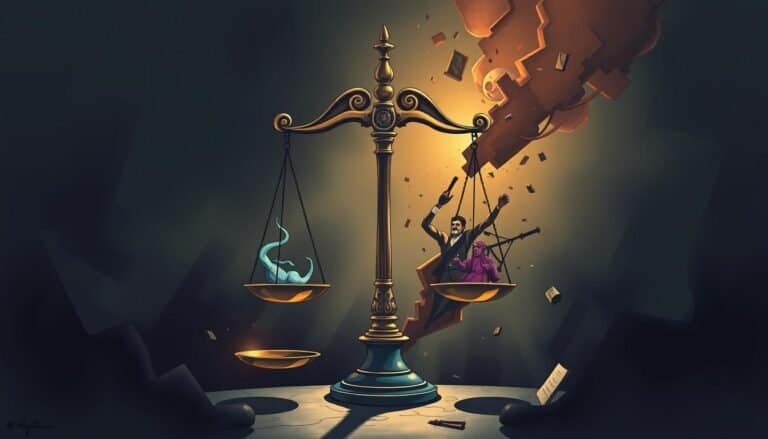Philosophical Theories of Justice: Rawls vs. Nozick
Imagine if justice in society wasn’t just about laws, but a deep philosophical debate. The debate between John Rawls and Robert Nozick has changed how we think about justice. They offer two different views that make us think and talk a lot. Rawls believes in a system that focuses on making sure everyone is fairly wealthy and happy. Nozick, on the other hand, thinks that giving people their rights and keeping the government small is key to justice.
It’s important to understand their views. Not just for learning about justice theories, but also for seeing how our society works. Their ideas help us think about what justice really means.
Key Takeaways
- Rawls supports making sure the poorest people are helped, but Nozick doesn’t agree with this.
- Nozick believes in a small government, while Rawls thinks a bigger government is needed for fairness.
- Rawls thinks we should have safety nets, but Nozick sees taxing for social programs as unfair.
- For Rawls, justice means helping the least well-off. Nozick focuses on fair ways of getting and sharing wealth.
- Both philosophers have abstract theories of justice, but they don’t really talk about how to apply them in real life.
- Rawls uses the “veil of ignorance” to figure out what justice looks like.
- Nozick uses the story of Wilt Chamberlain to show how people choose to trade and become wealthy.
Introduction to Philosophical Theories of Justice
Philosophical theories of justice talk about our moral duties and how societies should be organized. Rawlsian Justice and Nozickian Justice are two main views on sharing wealth, freedom, and equality. These theories are key to understanding political thought.
Rawlsian Justice, from John Rawls’ “A Theory of Justice,” values fairness and equal sharing. It has two main ideas: the Liberty Principle, which ensures everyone has basic rights, and the Difference Principle, which says social and economic differences are okay if they help the most disadvantaged. This way, it balances personal freedom with the common good.
Nozickian Justice, on the other hand, puts a big focus on individual rights and the idea of owning things. Robert Nozick argues that taking wealth from one person and giving it to another goes against personal freedom. His ideas are about how to get things right after past wrongs, not just making everyone equal.
The debate between these theories brings up big questions about what a fair society looks like. It shows how Rawlsian Justice values fairness and Nozickian Justice stands up for individual rights. This helps us see the deeper discussions in political and moral thought.
| Theory | Key Focus | Principles | Critique |
|---|---|---|---|
| Rawlsian Justice | Fairness and equality | Liberty Principle; Difference Principle | Seen as weak by some; “Just Desserts” argument from the right |
| Nozickian Justice | Individual rights and entitlement | Justice in acquisition, justice in transfer, rectification | Dismisses social responsibility; focus on individualism |
Overview of John Rawls’ Theory of Justice
John Rawls’ Theory of Justice, introduced in “A Theory of Justice” in 1971, changed political philosophy. It focuses on fairness and building a just society. Rawls laid out two main principles to guide his theory. These principles deal with justice, highlighting individual rights and fairness in society.
Key Principles of Rawlsian Justice
The first principle is about basic liberties. It’s called the Liberty Principle. It says everyone should have the same basic rights, like free speech and voting. Rawls believes in equal rights and freedoms for all, which is key to a just society.
The second principle is the Difference Principle. It says social and economic differences are okay if they help the least advantaged. This aims to make a system where wealth and opportunities help those who need it most, making society more fair.
Liberty and Difference Principles Explained
Rawls explains these principles with the “veil of ignorance” thought experiment. Imagine designing a society without knowing your own traits or status. This approach helps ensure fairness in creating social structures. Rawls calls this the Original Position, showing how a just society should focus on the least advantaged while protecting everyone’s freedoms.
Understanding Robert Nozick’s Libertarian Perspective
Robert Nozick’s ideas deeply affect today’s political thought. He believes in a small government that doesn’t get involved in many things. This view shapes his ideas on justice, who owns what, and individual rights.
Nozick thinks a Minimal State is best. This means a government that only looks after individual rights and makes sure contracts are followed. His idea is different from others, like John Rawls’, who want a bigger role for the state.
The Minimal State: Anarchy, State, and Utopia
In his famous book, *Anarchy, State, and Utopia*, Nozick explains his Minimal State idea. He says a good government should only protect life, liberty, and property. This way, smaller communities can have their own ideas of justice.
Nozick doesn’t like big welfare states. He thinks they take away people’s freedom and choices. He believes in keeping the government small to protect everyone’s rights.
Entropy in Economic Ownership: Nozick’s Views on Justice
Nozick thinks a distribution of wealth is fair if it comes from fair means. He uses the “Wilt Chamberlain” example to show how simple choices, like paying to watch a game, can change fairness. He says it’s okay if some people have more than others, as long as they’re better off than they would be otherwise.
He believes justice looks at how things were acquired and the results. This makes things more complex when thinking about fairness.
Philosophical Theories of Justice: Rawls vs. Nozick
John Rawls and Robert Nozick have shaped the debate on justice. They have different views on how to achieve fairness. This section will explore their ideas, focusing on liberty and equality.
Comparing the Approaches to Distributive Justice
John Rawls introduced his ideas in “A Theory of Justice.” He used the Veil of Ignorance thought experiment to promote fairness. This method helps make decisions without bias, aiming to improve the lives of the least well-off. Rawls believes in three main principles of justice: liberty, equal opportunities, and the difference principle.
Robert Nozick, on the other hand, took a libertarian stance in “Anarchy, State, and Utopia.” He believes in protecting individual rights and a small government. Nozick thinks justice comes from just getting and giving by choice, not from taking wealth from others.
Liberty vs. Equality: Core Conflicts and Agreements
Rawls and Nozick disagree on the balance between Liberty and Equality. Rawls wants to reduce economic differences to ensure justice. Nozick sees such efforts as a threat to freedom. Both agree justice is crucial but have different ideas on what a just society looks like.
Comparing Rawls and Nozick shows a key debate in political philosophy. It raises questions about the state’s role, justice, and the balance between individual rights and social duties. Their ideas continue to inspire thought on Distributive Justice and the ongoing debate between liberty and equality.
| Aspect | John Rawls | Robert Nozick |
|---|---|---|
| Key Work | “A Theory of Justice” | “Anarchy, State, and Utopia” |
| Approach to Justice | Justice as Fairness | Entitlement Theory |
| Core Principles | Liberty, Equality, Difference Principle | Individual Rights, Minimal State |
| View on Redistribution | Support for Limited Redistribution | Opposition to Redistribution |
| Philosophical Influence | 20th Century Political Philosophy | Libertarian Political Philosophy |
Social Contract Theory in Rawls and Nozick’s Work
Social Contract Theory is key to understanding justice in the ideas of Rawls and Nozick. They imagine a deal among people in a society, showing how we all agree on what’s fair. But, they have very different ideas about how the government should work and protect our rights.
Common Ground: The Philosophical Basis
John Rawls and Robert Nozick both use Social Contract Theory to share their views on justice. They say people agree to live together by certain rules. This idea helps us work together instead of fighting over everything.
Rawls brings a new twist with his “Theory of Justice.” He suggests we imagine we don’t know our own future to make decisions that are fair for everyone. This way, our personal likes and dislikes don’t affect what’s seen as just.
Divergence in State Function and Justification
Rawls and Nozick agree on some things but have big differences in how they see the role of the government. Rawls believes a strong government is needed to make sure everyone is treated fairly. He thinks it’s okay to have some differences in wealth if they help the poorest people.
Nozick, on the other hand, thinks the government should only protect our rights and keep laws. He believes the government should stay out of most things, focusing on just a few important tasks.
| Theorist | State Role | Key Principles |
|---|---|---|
| John Rawls | Extensive State, promoting social justice | Fair Liberty Principle, Difference Principle |
| Robert Nozick | Minimal State, protecting rights | Entitlement Theory, individual rights |
These different ideas show us the debate in political thought about what justice means and how the government should work. Understanding these differences helps us see the value of Social Contract Theory in our society today.
Distributive Justice: Rawls vs. Nozick’s Entitlement Theory
Distributive justice is a key topic in political philosophy. John Rawls and Robert Nozick have different ideas on how to make things fair. Rawls believes that it’s okay to have unequal wealth if it helps the poorest people. He thinks we all should work together for the good of everyone.
Rawls’ Difference Principle and Its Implications
Rawls believed in justice being fair. He said everyone should have the same basic rights. He also thought that economic and social differences should help the poorest people.
He suggested that the government should help the poor with things like welfare and healthcare. This way, society becomes more just and people’s lives get better.
Nozick’s View on Economic Inequality as Acceptable
Nozick, on the other hand, thinks people should keep what they have if they got it fairly. He believes in personal rights over the common good. He says taking wealth from one person to give to another is wrong.
Nozick thinks that people choose to be unequal on their own. He doesn’t think the government should fix these differences. He wants a small government that only looks after people’s rights and property.
| Theory | Key Principle | View on Inequality | Role of State |
|---|---|---|---|
| Rawls’ Theory | Difference Principle | Inequality is acceptable if it benefits the least advantaged | Active role in redistribution and welfare policies |
| Nozick’s Theory | Entitlement Theory | Inequality from just acquisition is morally acceptable | Minimal state focused on protecting rights and property |
Critiques and Challenges of Rawlsian and Nozickian Justice
Philosophers like John Rawls and Robert Nozick have shaped our ideas of justice. Rawls is a giant of the 20th century, but his Social Welfare Approach has faced criticism. Some say it might make people too dependent on others, leading to problems like the free-rider issue.
Critiques of Rawls’ Social Welfare Approach
Rawls wanted to balance liberty and fairness in his justice theory. He suggested high taxes for the common good, which sounds good but might not work. By limiting economic liberties, he faced questions about his plan’s reality.
His model might not fit today’s economy, critics say. This raises doubts about its use in our society.
Nozick’s Approach: Libertarian vs. Social Responsibility
Robert Nozick’s ideas have their own problems. He values individual rights, especially property rights. But, this could mean ignoring the need for social support.
Some argue that his view on wealth differences is too extreme. It might not help everyone in society. The libertarian ideas he supports could miss the mark on public goods and welfare.
| Theory | Key Focus | Main Critiques |
|---|---|---|
| Rawls’ Theory | Social Welfare Approach | May foster dependency, ignore economic liberties, and face feasibility issues. |
| Nozick’s Theory | Libertarian Approach | Lacks social responsibility, rejects safety nets, and promotes extreme wealth disparities. |
These debates show the deep differences in how we think about justice. Critiques of Rawls and challenges to Nozick offer valuable insights. They help us understand the balance between individual rights and our shared duties.
Similarities Between Rawls and Nozick
John Rawls and Robert Nozick have different views on justice but share some key similarities. They both value justice and liberty highly. They believe that certain principles of justice are crucial for society.
Common Principles of Justice and Liberty
Rawls suggests two main principles of justice. The first protects individual freedoms, and the second allows economic inequalities if they help the least well-off. Nozick, on the other hand, believes in a small government that mainly deals with contracts and crime. Yet, both thinkers focus on the big questions of justice in society.
Philosophy of Justice as a Central Concern
Rawls and Nozick both aim to deeply understand justice beyond just ethics. Rawls thinks that justice must shape a fair society. He imagines a scenario where everyone, free and equal, agrees on society’s rules.
Nozick believes in a society that respects individual rights. This allows people to make choices that might lead to economic differences. Both thinkers explore fairness, liberty, and the role of the state, showing their deep thoughts on justice.
| Aspect | John Rawls | Robert Nozick |
|---|---|---|
| Core Principle | Two principles of justice, including the difference principle | Minimal state, focus on contract enforcement |
| Economic Inequality | 允许经济不平等, if it benefits the least advantaged | Permits inequality from voluntary exchange |
| State’s Role | Involved in redistributing wealth for justice | Limited to protecting rights and contracts |
| Justice Framework | Social contract through fair conditions | Valuation of voluntary exchanges as just |
Practical Applications and Implications of Their Theories
The ideas of Rawls and Nozick have become key in today’s political talks. They help shape discussions on taxes, healthcare, and social welfare. These theories show how important they are in today’s government.
How Their Theories Impact Modern Political Philosophy
Rawls and Nozick’s ideas affect many political views and policies. Rawls talks about fairness in justice, which leads to talks on sharing income and giving everyone equal access to resources. Nozick, on the other hand, believes in individual rights and a small government, causing debates on personal responsibility versus social help. These discussions show how justice keeps changing in politics.
Real-Life Examples of Justice Theories in Action
There are many real examples of how justice theories work in the world. Let’s look at a few:
| Scenario | Rawlsian Approach | Nozickian Approach |
|---|---|---|
| Healthcare Access | Universal coverage based on need | Private insurance with minimal regulation |
| Taxation Policy | Progressive taxation to reduce inequality | Flat tax with no redistribution |
| Social Welfare Programs | Support for disadvantaged groups | Focus on individual financial independence |
These examples show how politicians use these theories to support or oppose policies. Mixing Rawlsian and Nozickian ideas shows the complex nature of justice in politics. Using these theories correctly can lead to different results based on the society and goals.
Conclusion
John Rawls and Robert Nozick have given us two big ideas about justice. They show us how we can think about fairness and equality in different ways. Rawls believes in a fair system where everyone gets a chance and the least well-off are looked after. Nozick, on the other hand, thinks that people should keep what they earn and the government shouldn’t take their stuff.
These ideas show us how we see society and its problems. Rawls makes us think about justice without bias, aiming for a fair and cooperative society. Nozick argues for less government, focusing on our rights as individuals. This highlights the debate between personal freedom and the needs of everyone.
These theories are still very important today. They make us think deeply about how to balance freedom and equality. By understanding these ideas, we can talk better about justice and how to run our societies. It also makes us think about what we believe is fair in our changing world.
Source Links
- Essay: John Rawls and Robert Nozick: liberalism vs. libertarianism
- Philosophical Issues: Individuals and Society – Rawls and Nozick
- John Rawls, Robert Nozick, and the Difference Principle: Finding Common Ground
- Lecture 10 (Rawls and Nozick)
- John Rawls
- Rawls’s A Theory of Justice: An Introduction
- John Rawls & Justice | Issue 92
- John Rawls
- Robert Nozick – Entitlement Theory, Libertarianism, Anarchy
- Robert Nozick’s Political Philosophy
- Nozick, Robert: Political Philosophy | Internet Encyclopedia of Philosophy
- On John Rawls vs Robert Nozick
- Nozick and Rawls – John Rawls
- Social Contract Theories: Rawls and Nozick
- Distributive Justice
- Microsoft Word – 23. Louis Manyeli.doc
- Robert Nozick’s Entitlement Theory of Justice, Libertarian Rights and the Minimal State: A Critical Evaluation
- John Rawls and the Politics of Social Justice
- David Schmidtz on Rawls, Nozick, and Justice – Econlib
- The Later Rawls’s Critique of Libertarianism – Bleeding Heart Libertarians
- Rawl’s theory of justice and its practical Application
- Marx & Rawls vs. Nozick & the "Land Back" Left (UNLOCKED)
- Theories, Facts, and Meanings in Political Philosophy
- Distributive Justice | Internet Encyclopedia of Philosophy
- Summary and Analysis of John Rawls’ and Robert Nozick’s Thoughts on Justice







